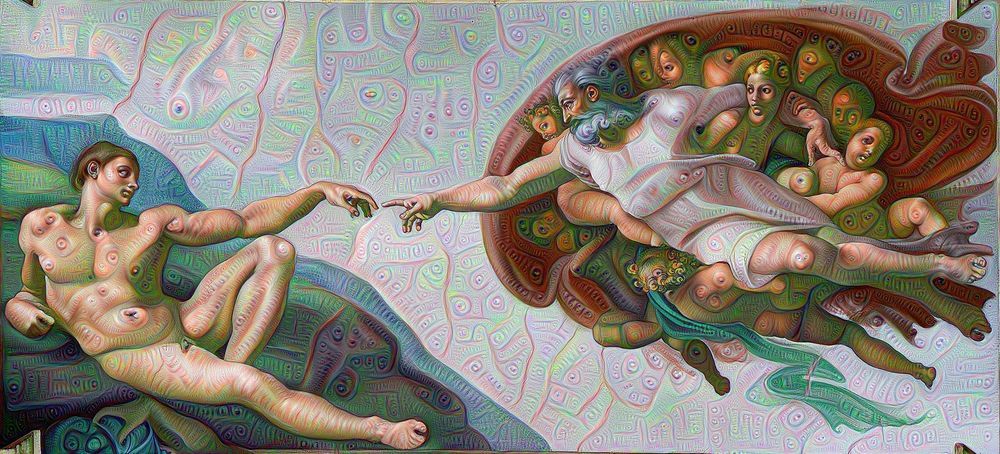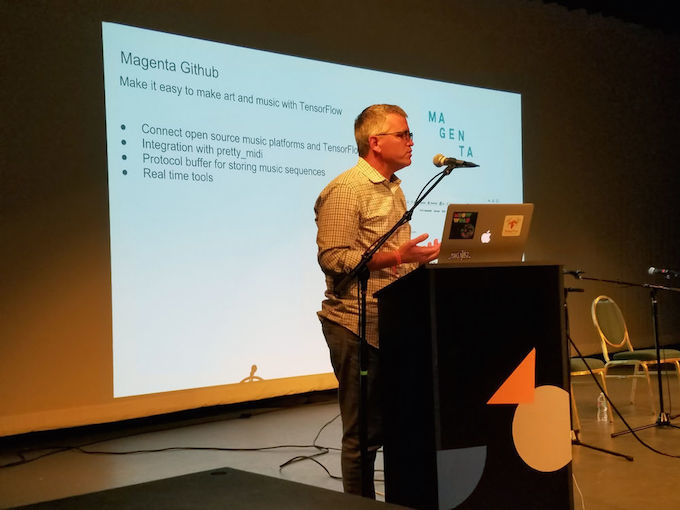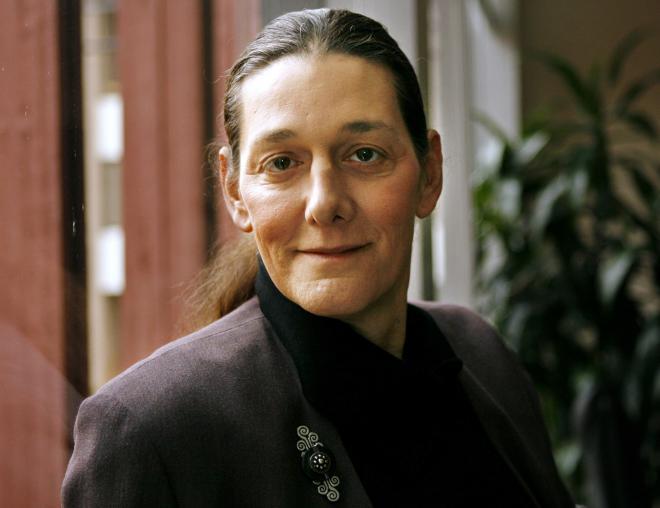Google's Magenta Project: Can a Computer Be Creative?
In the summer of 2015, a group of researchers from Google decided to make their dream in the field of artificial intelligence a reality and create a “creative computer”. Their program could not only classify images, but also modify them. Thus, the machine offered its own unique interpretation of a work of art.

The researchers concluded that they can also configure the program to generate images. This, in turn, provides valuable material for disclosing the creative mechanisms of a computer, helps to understand how the machine “thinks” when creating new objects based on an analysis of how concrete classical art objects were previously created. The discovery was made on the crest of a wave of popularity of the idea that a computer can be a creative tool.
')
Almost a year later, Google announced the launch of the project Magenta , in which the research group was to experiment with creativity and artificial intelligence. In their work, the team focused on creating art objects in various forms. It was supposed to pay special attention to creativity in the field of music and then direct the forces to creativity when working with materials in video format and a variety of visual media.
As the head of the project Douglas Eck writes in the first post of the Magenta blog :

Douglas Ek at the project presentation
The first project released by Magenta is a fairly simple melody based on the first four notes of the children's song “Twinkle Twinkle Little Star” . The work was done by Google researcher Elliot Waite. A melody created by a computer begins with simple notes composed on an electronic piano. But soon it becomes more and more complex and sophisticated. The song even contains some really good musical phrases (but drums were added later, by man).
From the very beginning, the developers tried to create artificial intelligence that would be able to make creative choices. The father of artificial intelligence, Marvin Minsky (Marvin Minsky), in 1960 wrote:
Of course, intelligence is more than the ability to recognize patterns and patterns of action. But still, the search for his "place" remains a tricky task for researchers of artificial intelligence, forcing them to take a fundamentally new position and modify the psychological methodology.
Martina Rosblatt (Martine Aliana Rothblatt), founder of Sirius XM, author futurologist and owner of the Bina48 robotic partner, says that for true creativity, a machine must be able to create more than just random samples of objects that we have already seen before.

Martina Rosblatt - founder of the Terasem Movement Scientific School
As Rosblat states in an interview for Popular Science :

Social robot Bina48
Recently, many projects have been implemented, the purpose of which was to overcome the threshold of originality of creative "perception" (especially in the field of visual arts and writing music). For example, with the help of modern developments, you can see how Picasso would draw a scene from the 21st century, or how Beethoven’s pompous feelings could be reproduced in musical themes.
These art projects (the researchers call them the “style transfer”), which is a subsection of artificial intelligence, helped to model the technique of various prominent artists for later use in creating a new product. During the research conducted in the German laboratory Bethge Lab , the developers conducted a series of manipulations with digital drawings, applying to them the styles of such masters as Pablo Picasso, Vincent Van Gogh, Wassily Kandinsky, and Edvard Munch.

In the upper left corner is the original photo, which was reworked in the styles of the paintings: “Shipwreck of the Minotaur” by William Turner (Shipwreck of the Minotaur by JMW Turner) - upper right corner, “Starry Night” by Vincent van Gogh (The Starry Night by Vincent van Gogh ) - lower left corner and Edward Munch's Creek (Der Schrei by Edvard Munch) - lower right corner
To do this, the developers used an algorithm that recognizes the objects depicted in the pictures. Due to this, it was possible to ignore directly the picture itself and focus on how these objects are depicted. This made it possible to separate the content from the style of the painting and then study it more precisely.
Of course, some experts claim that the processed paintings are not a new product. In their opinion, this is just a reworking of the creativity created by a human being. In particular, futurologist Jaron Lanier (Jaron Lanier), who is the author of the term “virtual reality” and head of the research team at Microsoft, believes that the machine will never be truly creative.

Jaron Lanier - a scientist in the field of data visualization and biometric technology
As Lanier says:
The artificial intelligence researcher and creator of the Creative AI and Ethical Machines podcast sites, Samim Winiger, is convinced that creativity is a way of operating, not an inherited talent or a spark.
Vininger emphasizes:
Viniger himself considers such tools as a way to increase human creativity, and not as its replacement. In such a scenario, for example, a clothing store will be able to model a dress based on customer preferences and then, immediately on the spot, make everything.
And this idea has already been implemented in practice. For example, the IBM Watson supercomputer helped the fashion company Marchesa design a dress for the annual Met Gala, offering various color and material options. During the manufacturing process, Marchesa provided IBM Watson with five emotions: joy, passion, excitement, encouragement, and curiosity. IBM Watson analyzed previous dresses from Marchesa and, using his tool that combines colors with emotions, designed a set of color preferences for clothes. The computer support provided allowed us to narrow the fabric set from 40,000 in total to 150 variants and provide 35 design recommendations.
As Ek writes, the Magenta project aims to create truly creative music and visual art. The idea is to have nothing but the machine itself and by pressing one key immediately get a piece of music. And so that such a fragment contains all the elements that the composer could include in it.
In the future, Magenta will also work on digitally modifying music through repetition of musical themes and musical characteristics. It is not yet known when the program will be available to the public. At the moment, only the alpha version of Magenta has been released .

The researchers concluded that they can also configure the program to generate images. This, in turn, provides valuable material for disclosing the creative mechanisms of a computer, helps to understand how the machine “thinks” when creating new objects based on an analysis of how concrete classical art objects were previously created. The discovery was made on the crest of a wave of popularity of the idea that a computer can be a creative tool.
')
Almost a year later, Google announced the launch of the project Magenta , in which the research group was to experiment with creativity and artificial intelligence. In their work, the team focused on creating art objects in various forms. It was supposed to pay special attention to creativity in the field of music and then direct the forces to creativity when working with materials in video format and a variety of visual media.
As the head of the project Douglas Eck writes in the first post of the Magenta blog :
With the help of Magenta, we want to explore the downside - developing algorithms that can learn how to generate visual art and music products, in the long run creating intriguing and artistic content on our own.

Douglas Ek at the project presentation
The first project released by Magenta is a fairly simple melody based on the first four notes of the children's song “Twinkle Twinkle Little Star” . The work was done by Google researcher Elliot Waite. A melody created by a computer begins with simple notes composed on an electronic piano. But soon it becomes more and more complex and sophisticated. The song even contains some really good musical phrases (but drums were added later, by man).
Artistic intelligence
From the very beginning, the developers tried to create artificial intelligence that would be able to make creative choices. The father of artificial intelligence, Marvin Minsky (Marvin Minsky), in 1960 wrote:
I am absolutely sure that sooner or later we will be able to create programs capable of solving ambitious tasks - from complex combinations of heuristic techniques, planning algebra operations, methods for determining data dependencies - to recursive control procedures, etc. But we will not find a place for the intellect in any of these spheres.
Of course, intelligence is more than the ability to recognize patterns and patterns of action. But still, the search for his "place" remains a tricky task for researchers of artificial intelligence, forcing them to take a fundamentally new position and modify the psychological methodology.
Martina Rosblatt (Martine Aliana Rothblatt), founder of Sirius XM, author futurologist and owner of the Bina48 robotic partner, says that for true creativity, a machine must be able to create more than just random samples of objects that we have already seen before.

Martina Rosblatt - founder of the Terasem Movement Scientific School
As Rosblat states in an interview for Popular Science :
The most important element is idiosyncrasy (a distinctive feature, selectivity of susceptibility). If you have written a program that only randomly mixes elements, then there is no creativity. On the contrary, much depends on the individual view of the observer. If he is unique, then he will be creative.

Social robot Bina48
“Style Transfer”
Recently, many projects have been implemented, the purpose of which was to overcome the threshold of originality of creative "perception" (especially in the field of visual arts and writing music). For example, with the help of modern developments, you can see how Picasso would draw a scene from the 21st century, or how Beethoven’s pompous feelings could be reproduced in musical themes.
These art projects (the researchers call them the “style transfer”), which is a subsection of artificial intelligence, helped to model the technique of various prominent artists for later use in creating a new product. During the research conducted in the German laboratory Bethge Lab , the developers conducted a series of manipulations with digital drawings, applying to them the styles of such masters as Pablo Picasso, Vincent Van Gogh, Wassily Kandinsky, and Edvard Munch.

In the upper left corner is the original photo, which was reworked in the styles of the paintings: “Shipwreck of the Minotaur” by William Turner (Shipwreck of the Minotaur by JMW Turner) - upper right corner, “Starry Night” by Vincent van Gogh (The Starry Night by Vincent van Gogh ) - lower left corner and Edward Munch's Creek (Der Schrei by Edvard Munch) - lower right corner
To do this, the developers used an algorithm that recognizes the objects depicted in the pictures. Due to this, it was possible to ignore directly the picture itself and focus on how these objects are depicted. This made it possible to separate the content from the style of the painting and then study it more precisely.
Of course, some experts claim that the processed paintings are not a new product. In their opinion, this is just a reworking of the creativity created by a human being. In particular, futurologist Jaron Lanier (Jaron Lanier), who is the author of the term “virtual reality” and head of the research team at Microsoft, believes that the machine will never be truly creative.

Jaron Lanier - a scientist in the field of data visualization and biometric technology
As Lanier says:
Artificial intelligence works by re-using data from a person and his products. That is, creativity still comes from the person and the problem is that the person becomes anonymous. We have removed ourselves from the "equation".
The artificial intelligence researcher and creator of the Creative AI and Ethical Machines podcast sites, Samim Winiger, is convinced that creativity is a way of operating, not an inherited talent or a spark.
Vininger emphasizes:
You learn to be creative, you learn to play the guitar. If you look at this question from such an angle, then the creative process becomes demyspecified and you can start using tools to optimize your own processes.
Viniger himself considers such tools as a way to increase human creativity, and not as its replacement. In such a scenario, for example, a clothing store will be able to model a dress based on customer preferences and then, immediately on the spot, make everything.
And this idea has already been implemented in practice. For example, the IBM Watson supercomputer helped the fashion company Marchesa design a dress for the annual Met Gala, offering various color and material options. During the manufacturing process, Marchesa provided IBM Watson with five emotions: joy, passion, excitement, encouragement, and curiosity. IBM Watson analyzed previous dresses from Marchesa and, using his tool that combines colors with emotions, designed a set of color preferences for clothes. The computer support provided allowed us to narrow the fabric set from 40,000 in total to 150 variants and provide 35 design recommendations.
As Ek writes, the Magenta project aims to create truly creative music and visual art. The idea is to have nothing but the machine itself and by pressing one key immediately get a piece of music. And so that such a fragment contains all the elements that the composer could include in it.
In the future, Magenta will also work on digitally modifying music through repetition of musical themes and musical characteristics. It is not yet known when the program will be available to the public. At the moment, only the alpha version of Magenta has been released .
Source: https://habr.com/ru/post/395333/
All Articles